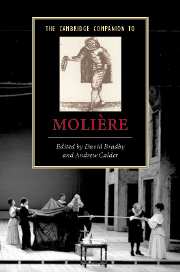Book contents
- Frontmatter
- 1 The career strategy of an actor turned playwright: 'de l’audace, encore de l’audace, toujours de l’audace’
- 2 The material conditions of Molière’s stage
- 3 The master and the mirror: Scaramouche and Molière
- 4 Molière as satirist
- 5 How (and why) not to take Molière too seriously
- 6 L’Avare or Harpagon’s masterclass in comedy
- 7 Laughter and irony in Le Misanthrope
- 8 Comédies-ballets
- 9 Le Bourgeois gentilhomme: Molière and music
- 10 Medicine and entertainment in Le Malade imaginaire
- 11 Molière and the teaching of Frenchness: Les Femmes savantes as a case study
- 12 L'École des femmes: matrimony and the laws of chance
- 13 Molière nationalised: Tartuffe on the British stage from the Restoration to the present day
- 14 Landmark twentieth-century productions of Molière: a transatlantic perspective on Molière: mise en scène and its historiography
- 15 Dom Juan the Directors’ Play
- 16 ‘Reculer pour mieux sauter’: modern experimental theatre’s debt to Molière
- Select bibliography
- Index
- Series List
2 - The material conditions of Molière’s stage
Published online by Cambridge University Press: 28 March 2007
- Frontmatter
- 1 The career strategy of an actor turned playwright: 'de l’audace, encore de l’audace, toujours de l’audace’
- 2 The material conditions of Molière’s stage
- 3 The master and the mirror: Scaramouche and Molière
- 4 Molière as satirist
- 5 How (and why) not to take Molière too seriously
- 6 L’Avare or Harpagon’s masterclass in comedy
- 7 Laughter and irony in Le Misanthrope
- 8 Comédies-ballets
- 9 Le Bourgeois gentilhomme: Molière and music
- 10 Medicine and entertainment in Le Malade imaginaire
- 11 Molière and the teaching of Frenchness: Les Femmes savantes as a case study
- 12 L'École des femmes: matrimony and the laws of chance
- 13 Molière nationalised: Tartuffe on the British stage from the Restoration to the present day
- 14 Landmark twentieth-century productions of Molière: a transatlantic perspective on Molière: mise en scène and its historiography
- 15 Dom Juan the Directors’ Play
- 16 ‘Reculer pour mieux sauter’: modern experimental theatre’s debt to Molière
- Select bibliography
- Index
- Series List
Summary
Molière’s Theatres
On 12 September 1643, the Illustre Théâtre, of which Molière was a member, rented the jeu de paume des Mestayers with the intention of converting it into a theatre. The first building in which Molière performed professionally was, therefore, a former tennis court. Paume had been popular since the Middle Ages, but had declined by the seventeenth century, leaving many buildings empty. There was at this time only one purpose-built theatre in Paris: the Hôtel de Bourgogne, constructed by the Confrérie de la Passion in 1548 for the production of mystery plays, on which it held the monopoly in the capital. These were soon banned, and the Confrérie profited from its premises by renting them out to the companies of actors newly circulating in France following the end of the Wars of Religion. Since its monopoly was interpreted as applying to all theatrical activity in the capital, troupes performing elsewhere, in an empty jeu de paume for example, were heavily fined. This was the situation until the 1630s, when, gradually, two more or less permanent troupes were established in the capital, one at the Hôtel de Bourgogne and the other in a jeu de paume in the Marais district, called simply the Théâtre du Marais. It was with these that the Illustre Théâtre had to compete.
Tennis courts did not make ideal theatres. They were long, narrow buildings (a three-in-one ratio of length to width was standard), and the sightlines from anywhere other than directly in front of the stage were poor. It had been thought that early companies converted these buildings by installing a second gallery opposite the existing spectators' gallery and building a simple trestle stage at one end.
- Type
- Chapter
- Information
- The Cambridge Companion to Moliere , pp. 15 - 36Publisher: Cambridge University PressPrint publication year: 2006

